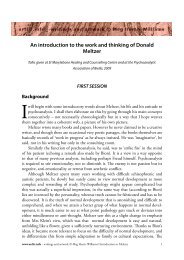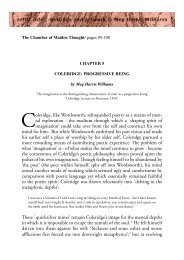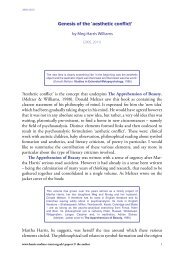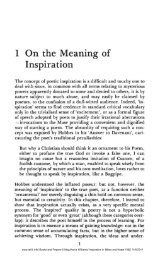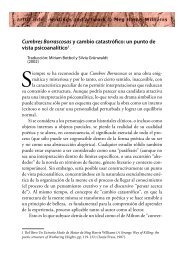Psychoanalytical observation: the artistic analogy - Artlit
Psychoanalytical observation: the artistic analogy - Artlit
Psychoanalytical observation: the artistic analogy - Artlit
You also want an ePaper? Increase the reach of your titles
YUMPU automatically turns print PDFs into web optimized ePapers that Google loves.
analyst’s attention to <strong>the</strong> patient’s co-operativeness” (Meltzer 1986, p. 208)– a process which he calls “counter-dreaming”. The transference and countertransferenceform <strong>the</strong> co-ordinates which enable <strong>the</strong> emotional experienceto be held for <strong>observation</strong>.The primary symbol in psychoanalysis is of course <strong>the</strong> dream. Meltzersaid in fact <strong>the</strong> only talent he had discovered in himself was reading dreams.It is <strong>the</strong> dream, he says, that ‘comes to <strong>the</strong> rescue’ of <strong>the</strong> analyst’s sense ofhis own helplessness, once he has recognised that he is merely <strong>the</strong> servantnot <strong>the</strong> master of <strong>the</strong> analytic process. But as Bion keeps reminding us,<strong>the</strong> dream that <strong>the</strong> patient brings is not <strong>the</strong> one he had <strong>the</strong> night before– when he had that dream he was somewhere else, in a different place, adifferent state of mind. Only <strong>the</strong> patient can ever know that dream. Thedream that actually occurs in psychoanalysis is <strong>the</strong> countertransferencedream, <strong>the</strong> only one <strong>the</strong> analyst can know.The countertransference, Bion says, constitutes valuable evidence thata psychoanalytic situation exists and “has reality” – that it is not purelyimaginary, even though imagination has helped to discover it. The mostessential aid <strong>the</strong> analyst can ever acquire in his quest for self-knowledgeis <strong>the</strong> patient - his partner in <strong>the</strong> investigation of observed phenomena.In order to truly observe <strong>the</strong> mind, two minds are required, so that thisdialogue can be set up. This process is initiated by <strong>the</strong> dream <strong>the</strong> patientrelates, but is observed by means of <strong>the</strong> ‘marks’ of <strong>the</strong> countertransferencethat <strong>the</strong> analyst discerns in his own mind. Dreams are generative – and anew dream is here created. It exists at that moment can <strong>the</strong>refore be scientificallyobserved. As Meltzer says, <strong>the</strong> dreamer is <strong>the</strong> thinker and <strong>the</strong>analyst <strong>the</strong> comprehender of his thought.Meltzer says that it was in <strong>the</strong> context of observing Martha Harris’ssupervisions of baby <strong>observation</strong>s that it became clear to him that ourconscious interpretive formulations are woefully inadequate for transcribing<strong>the</strong> sensitive ‘nuances’ of this ‘primal relationship’ (1981, p. 503). And<strong>the</strong> problem in <strong>the</strong> consulting room was analogous. He felt we should paymore attention to <strong>the</strong> ‘compositional’ aspects of <strong>the</strong> analytic situation inorder (he writes):to extend <strong>the</strong> scope of our <strong>observation</strong> of our functioning in <strong>the</strong> consultingroom,[because] a wider range of self-<strong>observation</strong> by <strong>the</strong> analyst could increasehis technical mastery of his behaviour in keeping with <strong>the</strong> individual patient’sneeds.’ (1981, p. 499).www.artlit.info - writings and artwork © Meg Harris Williams/ Psychoanalytic <strong>observation</strong> 5



